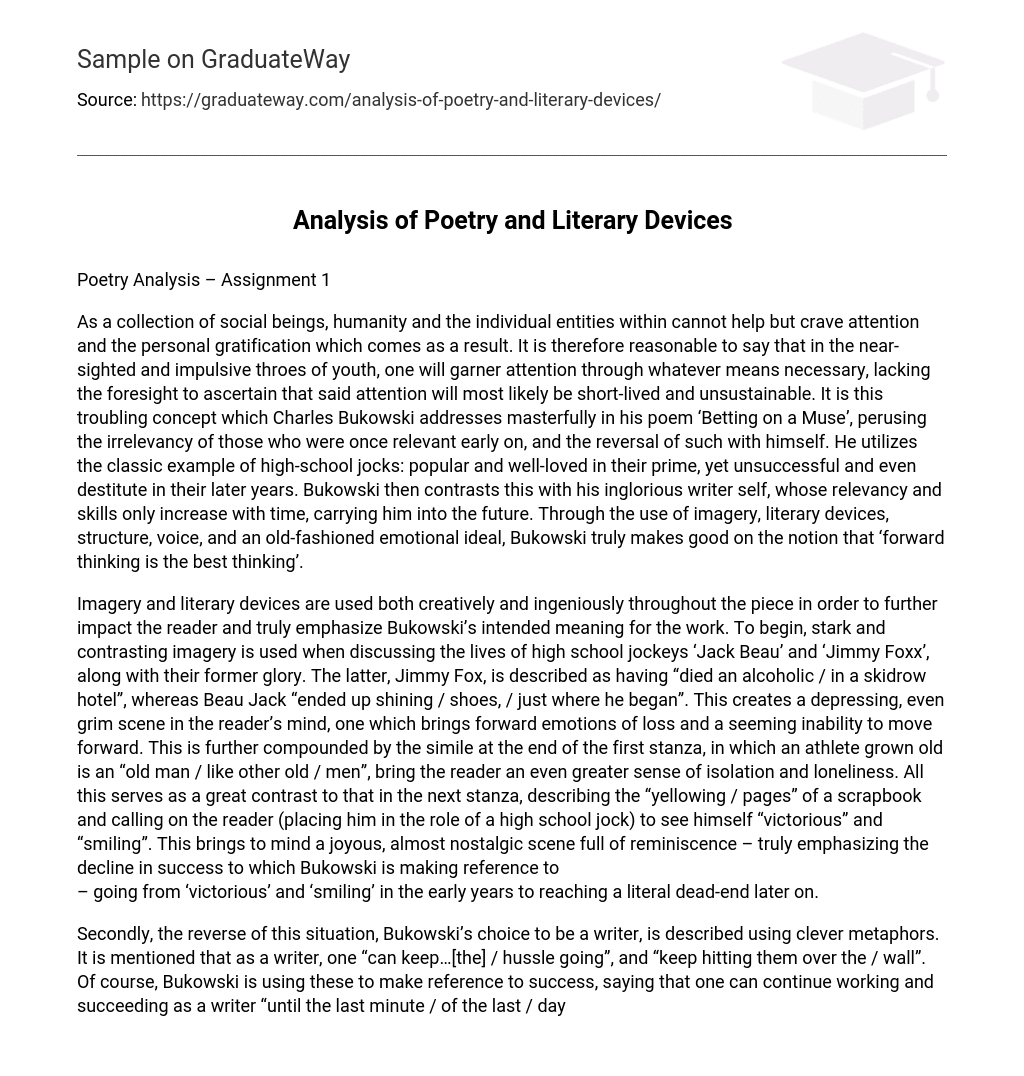Humanity and individuals naturally crave attention and personal gratification. This leads younger individuals to seek attention through any means possible, without considering that the attention might be short-lived and unsustainable.
In his poem ‘Betting on a Muse’, Charles Bukowski brilliantly delves into the troubling concept of irrelevancy and the reversal of fortune. He skillfully compares the fate of once popular high-school jocks, who end up unsuccessful and destitute, with his own writer self. Unlike them, Bukowski’s relevance and skills only grow with time, propelling him into the future. Through the use of imagery, literary devices, structure, voice, and an old-fashioned emotional ideal, Bukowski proves that ‘forward thinking is the best thinking’.
Throughout the piece, imagery and literary devices are utilized in a creative and ingenious manner to enhance the reader’s experience and emphasize Bukowski’s intended message. The portrayal of high school jockeys Jack Beau and Jimmy Foxx and their past achievements is characterized by stark and contrasting imagery.
The former, Jimmy Fox, died an alcoholic in a skidrow hotel, while Beau Jack ended up shining shoes, just where he began. This paints a bleak picture in the reader’s mind, evoking feelings of sadness and a perceived inability to progress. The simile in the first stanza comparing an aging athlete to other elderly men adds to the sense of isolation and loneliness.
In the next stanza, there is a stark contrast to the previous lines. It talks about the “yellowing / pages” of a scrapbook and asks the reader (imagining them as a high school jock) to envision themselves as “victorious” and “smiling”. This creates a joyful and nostalgic atmosphere, highlighting the decline in success that Bukowski is referring to. It shows the shift from being triumphant and happy in the earlier years to ultimately reaching a figurative dead-end later in life.
Furthermore, Bukowski employs clever metaphors to illustrate his choice to become a writer. He emphasizes the ability to persist in the writing hustle and overcome obstacles. He suggests that as a writer, one can continue to thrive and succeed until the very end. However, Bukowski’s brilliance lies in the ironic nature of these statements, as he previously asserted that success in athletics and writing rarely coexist. Clearly, Bukowski’s use of imagery and literary devices not only evoke emotions but also provide comic relief in an otherwise dark and intricate piece.
Additionally, the piece effectively utilizes its structure and voice, despite not being immediately apparent. At first glance, the poem consists of 5 stanzas with varying numbers of lines, which may seem ordinary. However, upon reading it, one can identify an intriguing pattern connecting the length of the first 4 stanzas with their respective content. These stanzas appear to follow a reverse chronological order, initially discussing aging high school jocks and gradually delving into their earlier years (albeit in a more negative tone, highlighting the passage of time).
One can observe a clear reduction in the size of these stanzas, going from 17 lines to 10, 8, and eventually 5 lines. It is possible to infer that Bukowski is employing this decrease as a metaphor for the duration of different phases in a jock’s life. The shortest phase represents achievement and popularity (stanza 4), while the longest indicates misery and despair (stanza 1), with the reminiscing phase falling somewhere in between (stanza 2).
The text emphasizes that achieving early success does not ensure long-lasting prosperity if it is based on an unstable foundation. Furthermore, there is a change in the narrative voice between stanzas. In the beginning, the poem explores the downfall of “Jimmy Foxx” and other instances of alcoholism from a third-person viewpoint. However, in the following stanza, Bukowski consistently uses “there you are,” shifting to a second-person perspective. In the last stanza, Bukowski even utilizes first person narration by expressing “that’s why I chose to be a writer.”
The text progresses from a third person perspective to a first and second person perspective, creating a sense of immersion for the reader. This transition establishes a connection between them and Bukowski in the final stanza, where he directly addresses the reader. By saying “you can keep / getting better / instead of worse, / you can still keep hitting them over the wall,” Bukowski offers encouragement.





